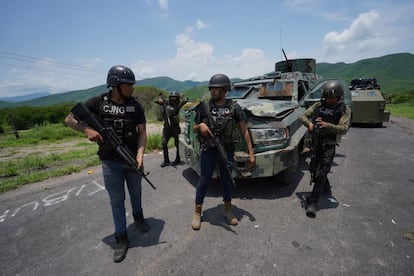In sign of escalating violence, Mexico’s narcos plant land mines in Tierra Caliente
An elderly farmer has died after stepping on an explosive device planted by the powerful Jalisco New Generation Cartel, a criminal group that authorities are wrestling to bring under control

An elderly man en route to his plot of land in Aguaje, Aguililla, in Mexico’s western state of Michoacán, was blown up by a mine planted by one of Mexico’s most dangerous drug gangs, Jalisco New Generation Cartel (CJNG). His son was also seriously injured by the blast. The farmer’s body was still lying on the ground when the authorities turned up at the scene on Saturday. Cristóbal “N” – the name provided by Mexico’s Prosecutor’s Office – died instantly.
This is the latest incidence of drug traffickers using a homemade explosive in Tierra Caliente, a region dominated by organized crime. Federal forces have now moved in to unseat the powerful CJNG from their headquarters.
The use of land mines is reminiscent of the terrorist strategy used by Colombian guerrillas against the local population and reflects the unimpeded escalation of the cartel’s violence and the extent of their power.
According to the authorities, land mines have been sown liberally around Aguililla and in at least a dozen other municipalities with the aim of killing military personnel deployed by the federal government.
The incident took place just two weeks after another mine was triggered by a convoy of soldiers on the border between Aguililla and Tepaltepec. The explosion destroyed an armored vehicle and one of the soldiers was seriously injured. The Defense Ministry has deployed a bomb squad to the area, which is considered “a minefield,” although precise high-risk zones are still to be cordoned off.
According to the Defense Ministry, the most common type of mine consists of a one-inch-thick metal tube filled with explosive and metal fragments, with the destructive potential of a fragmentation grenade.
Aguililla is the birthplace of America’s most-wanted drug lord, Nemesio Oseguera Cervantes, otherwise known as “El Mencho,” who is the leader of CJNG. The US Drug Enforcement Administration (DEA) is offering a $10 million reward for a lead on his possible whereabouts – the highest reward to date.
El Mencho founded CJNG in 2010 as the armed wing of the Sinaloa cartel, which was then at war over the control of the Gulf of Mexico with Los Zetas cartel, itself comprised of elite ex-military personnel, infamous for their random mutilations.
In September 2011, the CJNG left its letter of introduction in the heart of Zeta territory: 35 corpses on Ruiz Cortines Avenue in an exclusive area of Boca del Rio in Veracruz. The massacre earned them the nickname, Los Mata Zetas – The Zeta Killers. In 2015, after a failed operation to arrest El Mencho, the cartel shot down a military helicopter using a rocket launcher.

El Mencho’s organization has been flourishing in the shadow of more notorious organized crime gangs, such as Sinaloa, Los Zetas and Los Caballeros Templarios. While security forces focused on breaking the back of the big mafias during former Mexican president Felipe Calderon’s war on drugs (2006-2012), which was continued by Enrique Peña Nieto until 2018, the relatively fledgling JNGC was busy taking over its enemies’ turf.
Since then, the cartel has extended its reach across the whole of Mexico, aside from the areas controlled by the Sinaloa cartel. In fact, apart from the state of Sinaloa, there is not a corner of the country free of the gang’s allies, all of whom boast their allegiance to it when carrying out executions. Now El Mencho’s men parade with impunity through Michoacán state with tanks, heavy artillery and other weapons more typical of a war in the Middle East.
On February 8, soldiers and members of Mexico’s Secretariat of National Defense (Sedena) and the National Guard, assisted by the state police, moved in on Aguililla but there was not a single arrest. According to the Sedena, the armed forces arrived to “strengthen the rule of law” in the Tierra Caliente region, the bureaucratic formula for saying they had established a presence in one of the most violent corners of the country.
It is a worrying reflection of how the violent tactics used by criminal groups in Michoacán have evolved; increasingly they resemble those of the armed forcesRomain Le Cour, coordinator of the Security and Violence Reduction Program
The authorities’ arrival in Aguililla is part of a three-pronged strategy, the first of which is to free the roads and nearby rural areas without confrontation. The second, according to the army, has been to establish the presence of paratroopers, special and infantry forces, National Guard personnel and Michoacán police. And the third, according to the government, will consist of social initiatives and money for educational programs.
Romain Le Cour, the coordinator of the Security and Violence Reduction Program at the think tank Mexico Evalua, who has worked in the area, says that what has taken place “highlights the complexity of what is happening in Michoacán. Many people will use the incidents to paint it as an armed conflict or civil war,” he adds. “But that is not the context. Rather, it is a worrying and dramatic reflection of how the violent tactics used by criminal groups in Michoacán have evolved; increasingly they resemble those of the armed forces, on account of their firepower and operational capacity. What is significant is the focus on Michoacán as a political laboratory regarding Mexico’s violence, following more than 15 years of practices new to the country that have spread to the rest of the region. That is why it is important that it is resolved, something that the federal government is failing to do correctly.”
Consequences of the federal deployment in the area were observed on February 13 in the shape of an armed attack in Cuitzeo on military personnel who were patrolling oil pipelines. No one has been arrested. The wounded soldiers were taken to the hospital, although Sedena has not released any information on the gravity of their injuries.
The following day, soldiers from the bomb squad were checking for mines. Sedena has not yet reported how many the cartel may have planted.
Tu suscripción se está usando en otro dispositivo
¿Quieres añadir otro usuario a tu suscripción?
Si continúas leyendo en este dispositivo, no se podrá leer en el otro.
FlechaTu suscripción se está usando en otro dispositivo y solo puedes acceder a EL PAÍS desde un dispositivo a la vez.
Si quieres compartir tu cuenta, cambia tu suscripción a la modalidad Premium, así podrás añadir otro usuario. Cada uno accederá con su propia cuenta de email, lo que os permitirá personalizar vuestra experiencia en EL PAÍS.
¿Tienes una suscripción de empresa? Accede aquí para contratar más cuentas.
En el caso de no saber quién está usando tu cuenta, te recomendamos cambiar tu contraseña aquí.
Si decides continuar compartiendo tu cuenta, este mensaje se mostrará en tu dispositivo y en el de la otra persona que está usando tu cuenta de forma indefinida, afectando a tu experiencia de lectura. Puedes consultar aquí los términos y condiciones de la suscripción digital.
More information
Últimas noticias
Most viewed
- Sinaloa Cartel war is taking its toll on Los Chapitos
- Oona Chaplin: ‘I told James Cameron that I was living in a treehouse and starting a permaculture project with a friend’
- Reinhard Genzel, Nobel laureate in physics: ‘One-minute videos will never give you the truth’
- Why the price of coffee has skyrocketed: from Brazilian plantations to specialty coffee houses
- Silver prices are going crazy: This is what’s fueling the rally











































